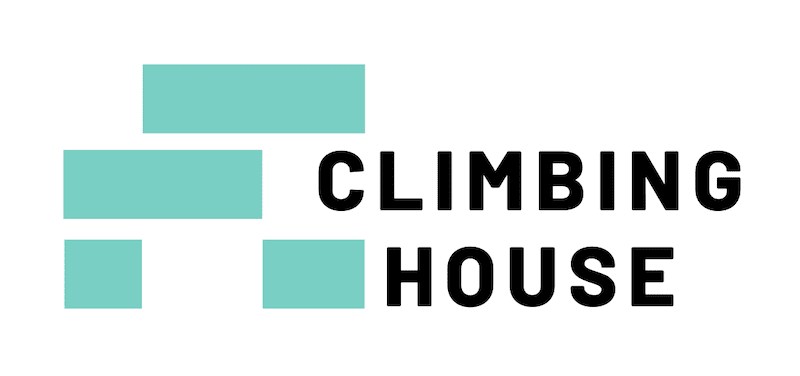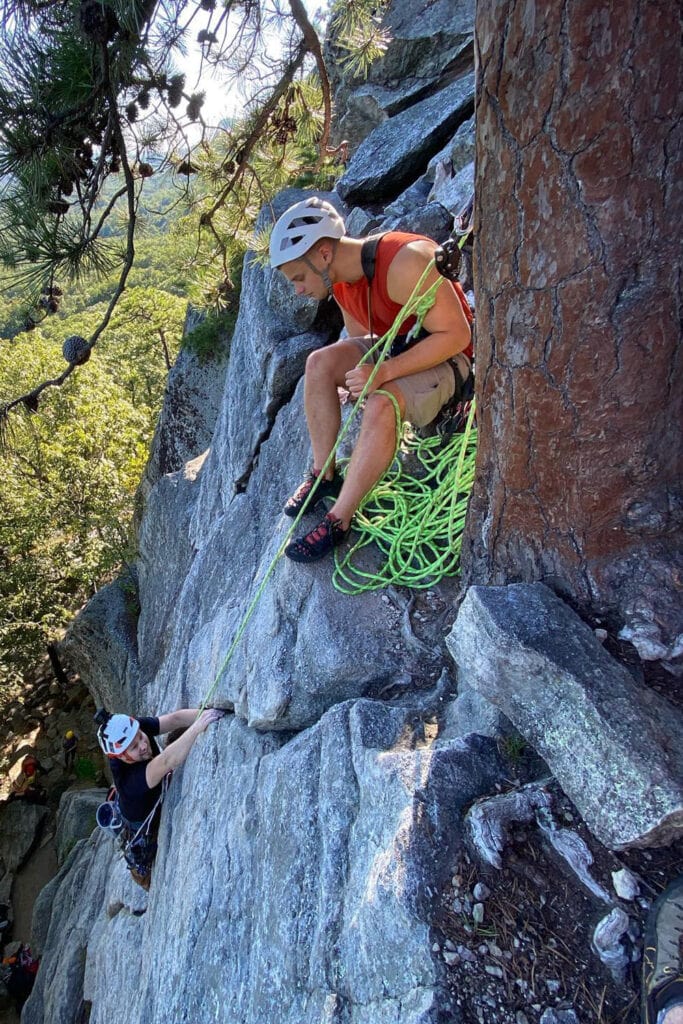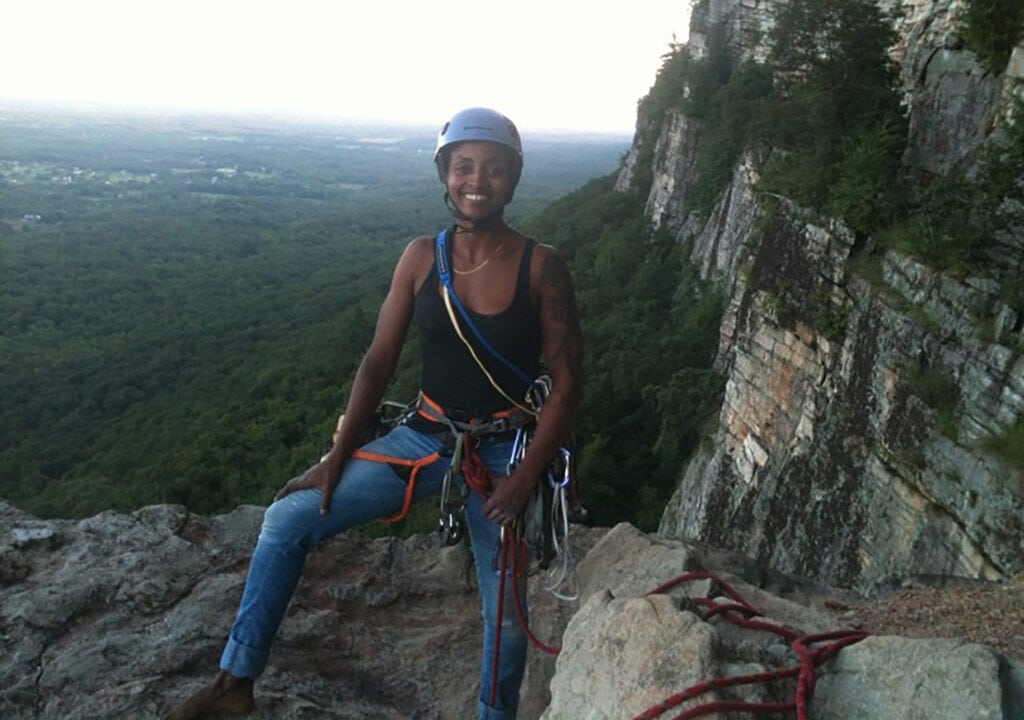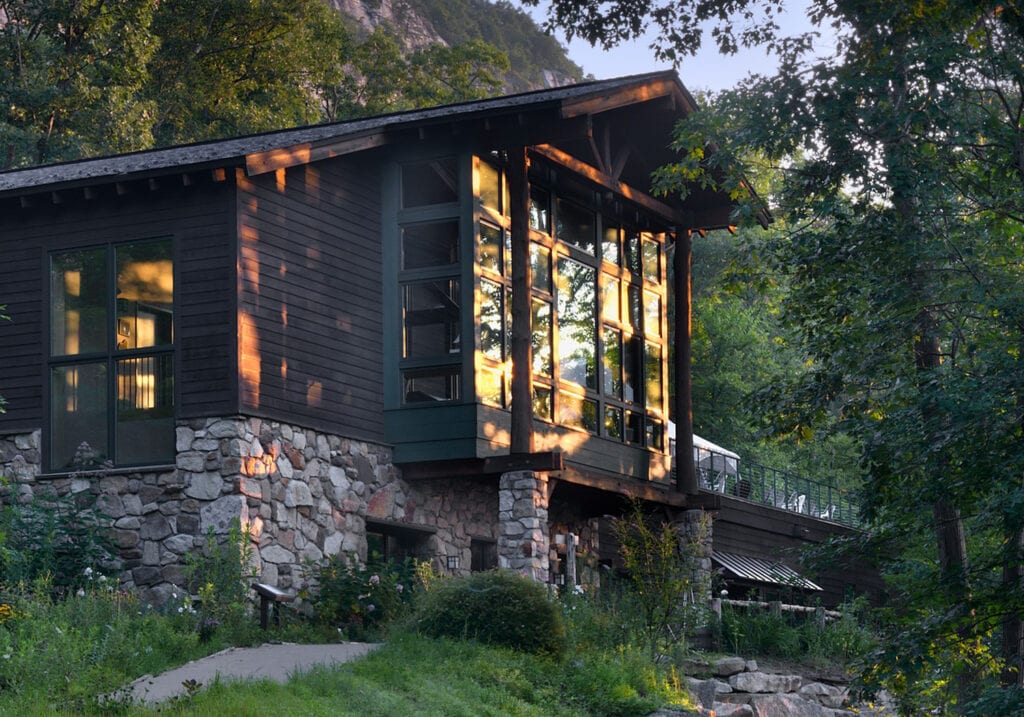The Gunks Climbing Guide for a Great First Trip (2024)
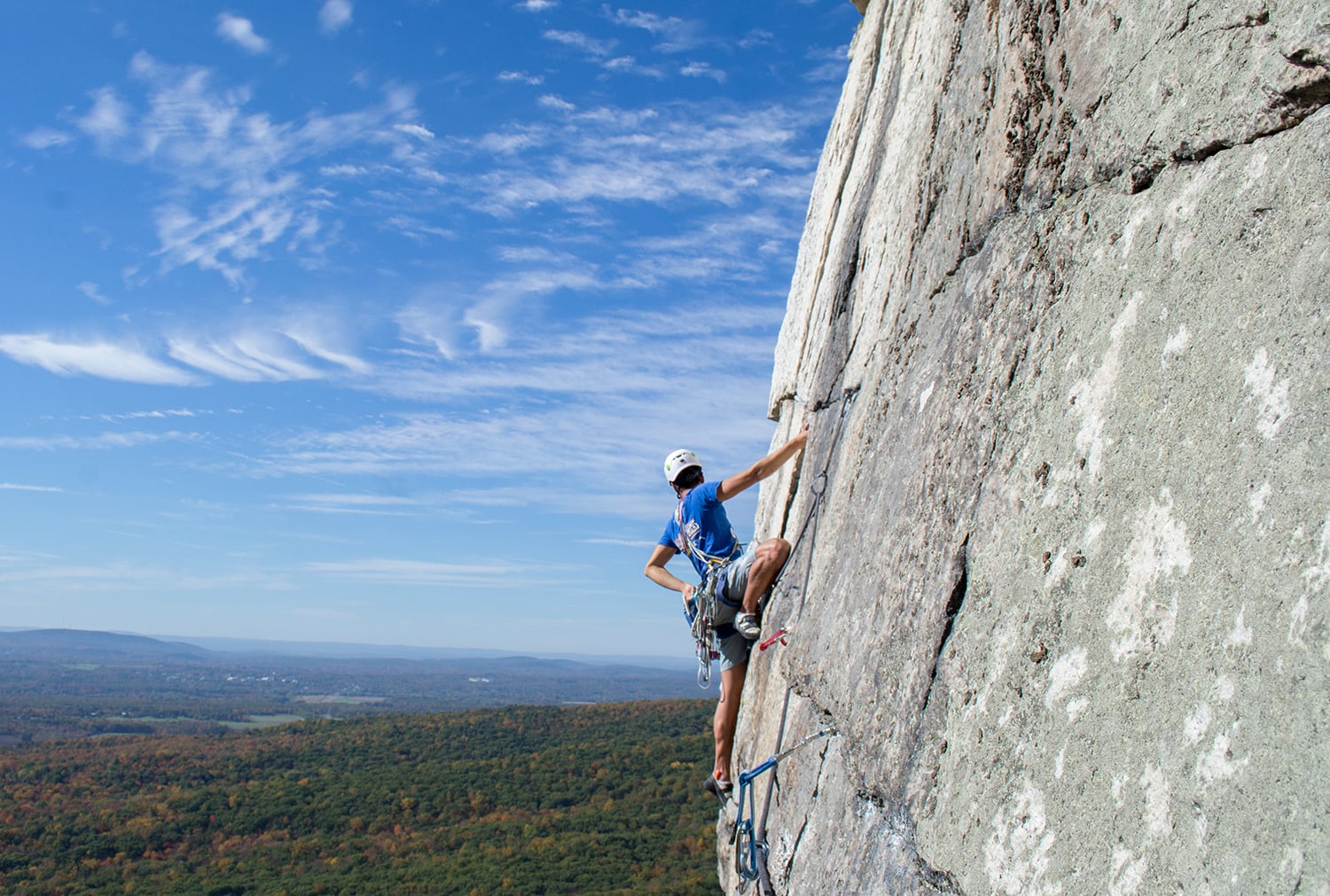
Published on: 12/02/2022
If you are a super-fan of North American rock climbing or rock climbing in general, then you have probably heard of the Gunks. And for a good reason. The traditional rock climbing at the Gunks is one of a kind.
Climbers have been enjoying the Gunks climbing for decades. The original first ascensionists of the Gunks were putting up climbs in the late 1930s and 1940s. Since then, climbers from all over the world have pegged the Gunks as a must-visit climbing destination.
Keep reading to learn all you need to know to make your first trip to the Gunks as memorable and classic as the routes you will be climbing.
What’s So Special About the Gunks?
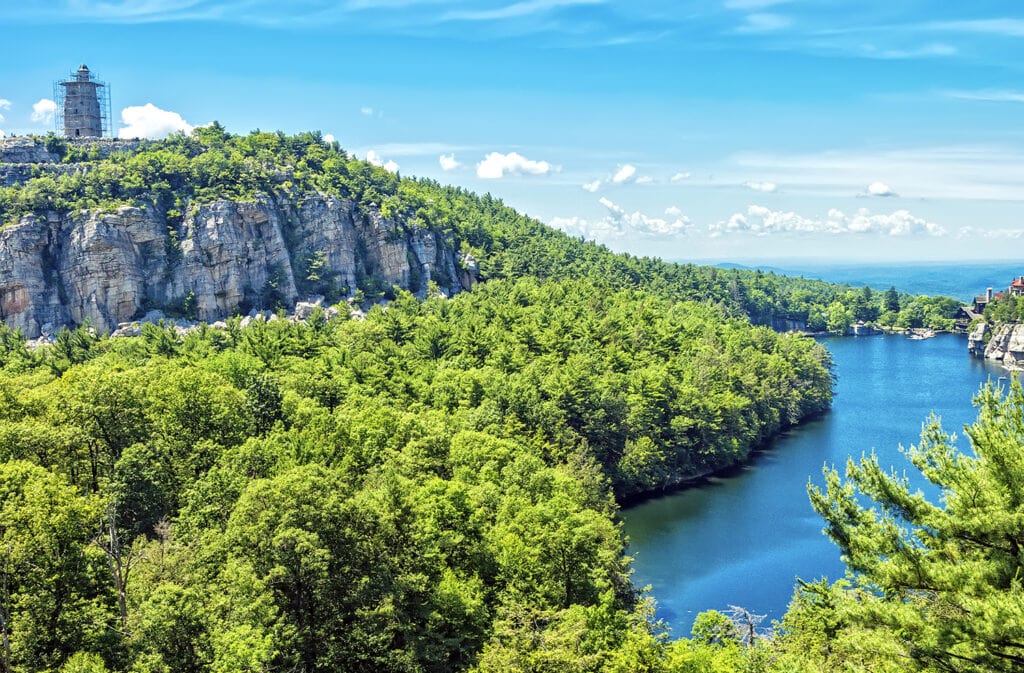
The Gunks, abbreviated from Shawanagunks, is one of the United State’s premier climbing areas. It is located outside New Paltz, NY– less than 100 miles from the NYC metro area. The ridgeline of the Shawangunk ridge runs West along the Hudson River and southwest all the way to Virginia.
The climbing at the Gunks is unique because of its geological history (1). The rock is a quartz conglomerate with some shale. The rock was deposited 400 million years ago as quartz gravel and sand. Over time, the Appalachian mountains eroded the Shawangunk deposits. As the sediments were dropped by rivers, they became buried deeper and deeper. The quartz then crystallized out of the groundwater in the sediments and cemented the gravel and sand together.
This type of bullet-hard rock lends itself to exciting climbing characterized by burly bulges and roofs, jugs, traverses, big air, and huge exposure. The Gunks is famous for its one to three-pitch routes and accessibility to easy and moderate trad routes. There are some bolted climbs at the Gunks, but the out-of-state climber should be wary– these are not considered sport climbs.
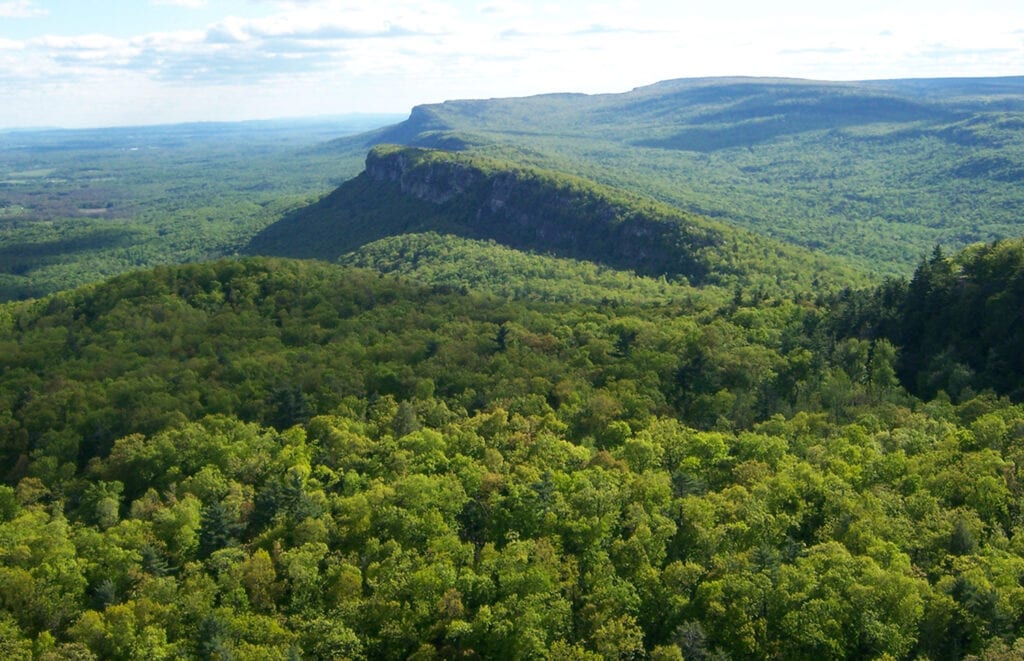
Native American History of the Gunks
Before climbers began frequenting the Gunks, the luscious countryside and (Hudson) River valley were home to the Lenape Native Americans.
The Lenape territory spanned the Northeastern woodlands of the now-United States, including Delaware, New Jersey, Pennsylvania, and New York. Dutch colonists first encountered the Lenape Peoples of the Muhheakunnuk Valley in the 1600s during what became known as the Esposus Wars.
It is said that the smoke from the various destroyed and burning Lenape shelters and structures cast a thick smoke over the valley, which is how some historians think the area got its name, Shawangunk, which translates to “in the smokey air.”
Other Native American experts believe Shawwangunk translates to “land where you go south,” referring to the southerly direction of the ridgeline.
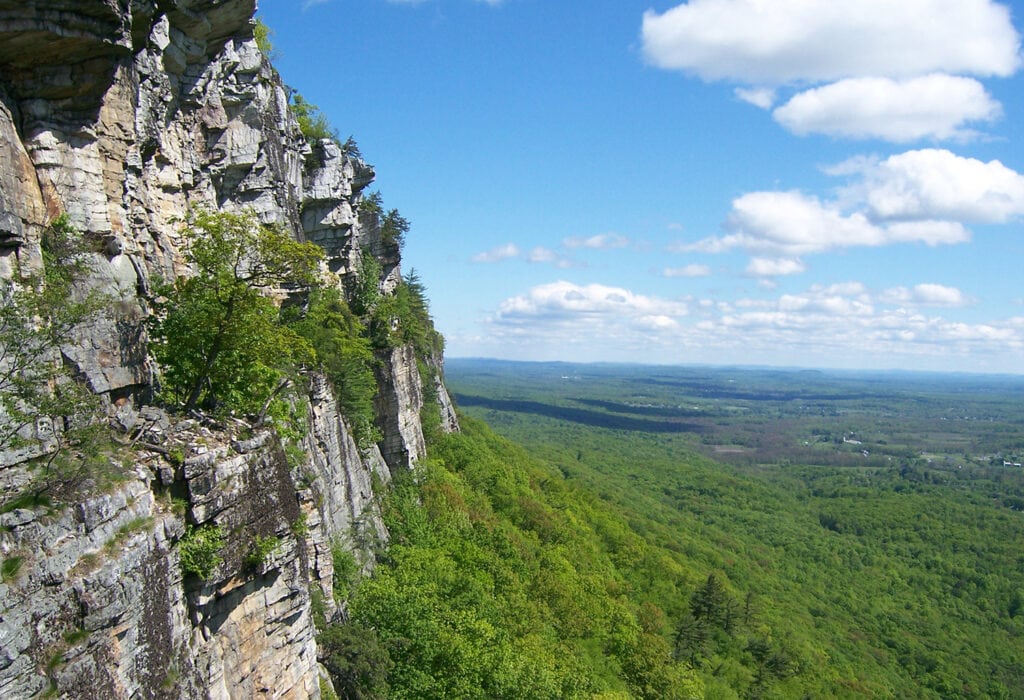
Regardless of the origin, it’s undeniable that the Shawangunk mountains were enjoyed and appreciated for their beauty and natural resources well before climbers began scaling the cliffs.
Although only briefly summarized here, the Native American history of the area is deserving of recognition. We recommend learning more about the Lenape (2) before your visit to the Gunks, and for every future climbing destination you wish to visit.
How to Get There and Move Around
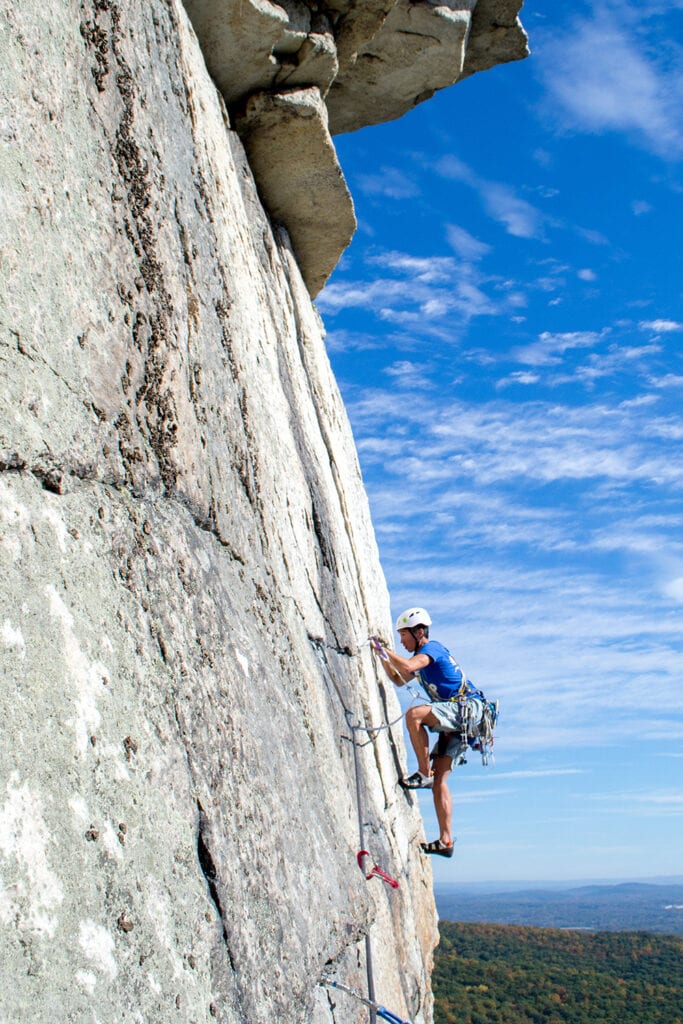
There is good news about getting to the Gunks– it’s easy. Three main modes of transportation will help you reach the sandstone cliffs of the world-renowned Gunks. Depending on your budget and travel style, you will find one that works for you.
1. By Air
The Gunks is a domestic and international climbing destination. Therefore, it makes perfect sense to travel by air to get there. Fortunately, you will have multiple airports to choose from if you do decide to fly– Albany International Airport (ALB), Newark Liberty International Airport (EWR), John F. Kennedy International Airport (JFK), and LaGuardia Airport (LGA).
Most of these options will be between one and two hours away from the Gunks, with traffic being the major obstacle after arrival. Nonetheless, the long leg of your journey would be over, and a simple car, train, or bus ride is all that stands between you and climbing overhanging rock and plugging gear into the horizontal cracks of the Gunks.
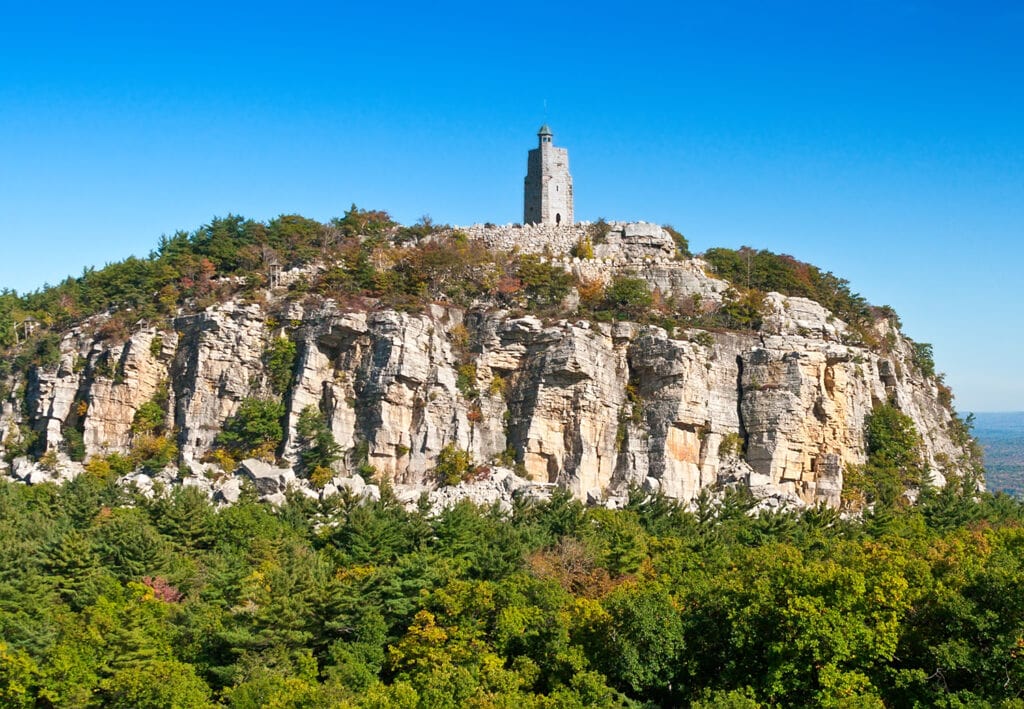
2. By Car
As you can imagine, one of the simplest ways to get to the Gunks is by car. Simply plug your destination into your car or smartphone navigation app and follow the directions. Don’t miss exit 18 for New Paltz on the New York Thruway. And remember– there are a lot of tolls on the New York Thruway, so be ready to travel with small bills and loose change, or bite the bullet and set up an E-ZPass (3) for your travels.
One of the best things about climbing is that it happens with friends. That is why we recommend carpooling. You can share the cost of tolls and fuel, put fewer cars on the road, and fit better into your campsite after you arrive. Plus, it’s more fun than driving alone.
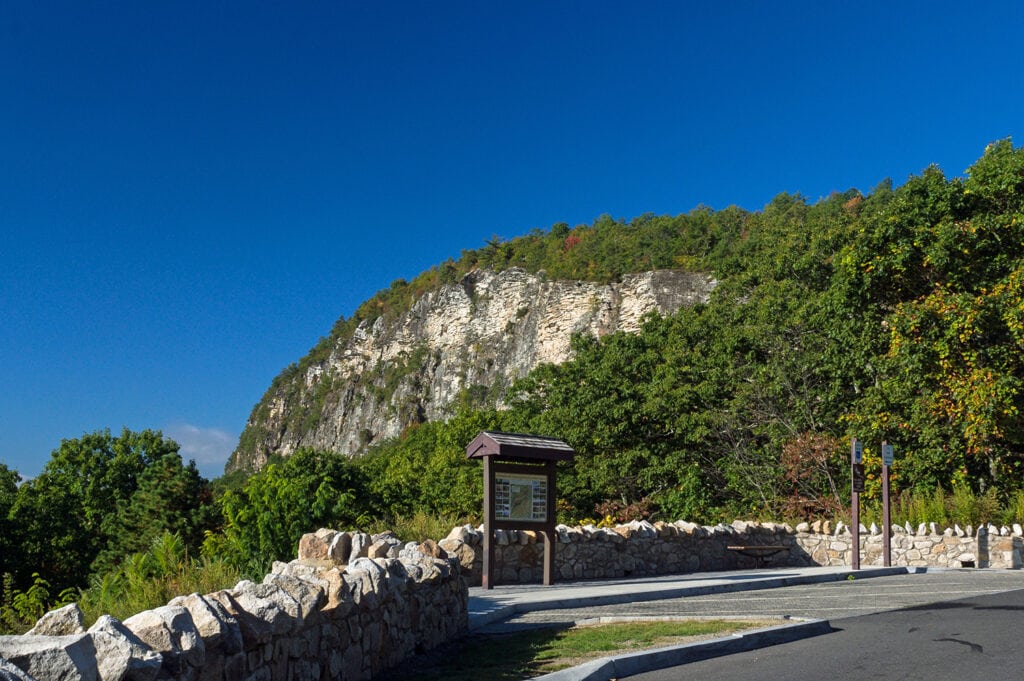
3. By Train
Traveling to the Gunks by train is a good option– especially if you find yourself coming from the city or somewhere in between. Amtrak (4) leaves from Penn Station in NYC and stops in Poughkeepsie on its way farther North.
The northbound Metro train (5) also leaves from Grand Central Station in NYC and will take you to Poughkeepsie. From there, a friend or local tax service can take you the rest of the way. Or you can head to the bus station and link with the Ulster Country Area Transit (6) (UCAT) bus service.
Once you arrive in New Paltz, the hard part is over, and now the fun can begin. The only thing left to do is pitch your tent at your campsite or check in to your hostel or hotel.
Where to Stay
There is no shortage of places to stay around the Gunks and in New Paltz. Each place will have its pros and cons. It’s just up to you to decide what sort of lodging experience you want to have.
Based on our research, here are five popular places to stay.
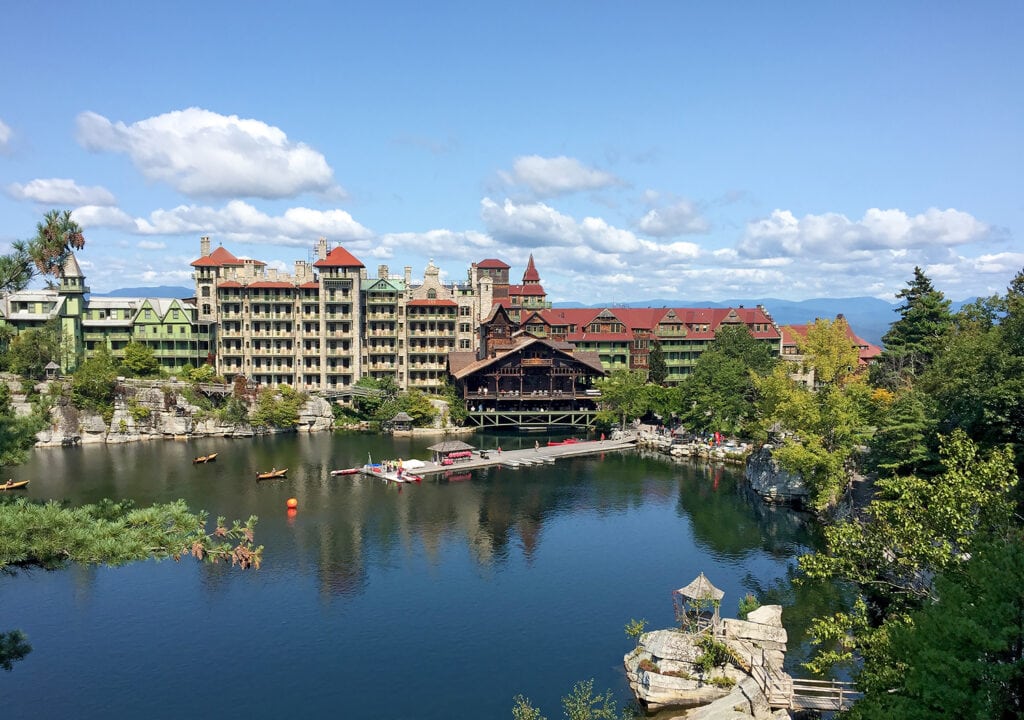
New Paltz Hostel
Other countries in Europe and Central or South America love their hostels, and for a good reason. They are fun and affordable places to stay while you travel. Thankfully, the folks at the New Paltz Hostel (7) understand this and built a place where climbers can stay short-term, live long-term, or exchange work for room and board.
Mohonk Mountain House
Only some trips to the Gunks have to include camping. If you are looking for a more romantic getaway, then the Mohonk Mountain House (8) is the place to be. It’s a gorgeous facility strategically located, so you can spend your morning hiking and climbing and evenings at the spa. As a guest of the Mountain House, you will also have access to the Sky Top climbing area, which can be guided by the only approved guide service– Alpine Endeavors.
The American Alpine Club Gunks Campground
If you plan to camp while you are at the Gunks, this is the place to be. It was made by climbers, for climbers. The AAC Gunks Campground (9) is the closest campground to the cliffs, so if you don’t mind walking, you don’t even have to move your car to go climb. It’s clean and has a covered communal gazebo and bonfire pit for socializing after getting home from the crags– although the camp host will eventually enforce quiet hours.
Yogi Bear’s Jellystone Park: Lazy River in Gardiner, NY
The Jellystone campground (10) in Gardiner is hard to beat if you travel as a family and love camping. This place is heaven on earth for kids and fun-loving families who enjoy an RV-style family campground.
The Minnewaska Lodge
One of the closest hotel-style accommodations to the Gunks is the Minnewaska Lodge (11). It’s a beautiful post and beam lodge building close to the Near Trapps. So if you like to climb, have free internet access, and sleep in a comfy bed, the Lodge is probably where you will end up.
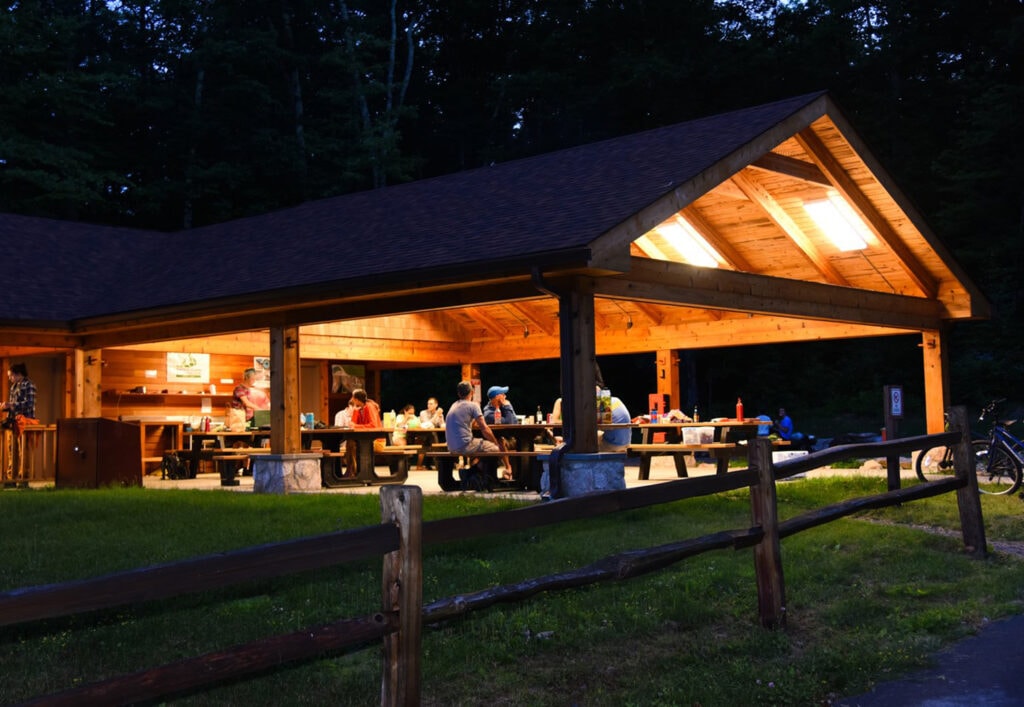
Presentation of Climbing Areas
There is no shortage of rock climbing at the Gunks. With climbs ranging from 5.3 to 5.14b, there is something there for every type of climber.
The Trapps
The Trapps is one of the most popular areas to climb at the Gunks. The area is about three miles long and boasts over 500 routes. The climbing at the Trapps ranges from one to three pitches. This area has many classic routes ranging from 5.6 to 5.11d.
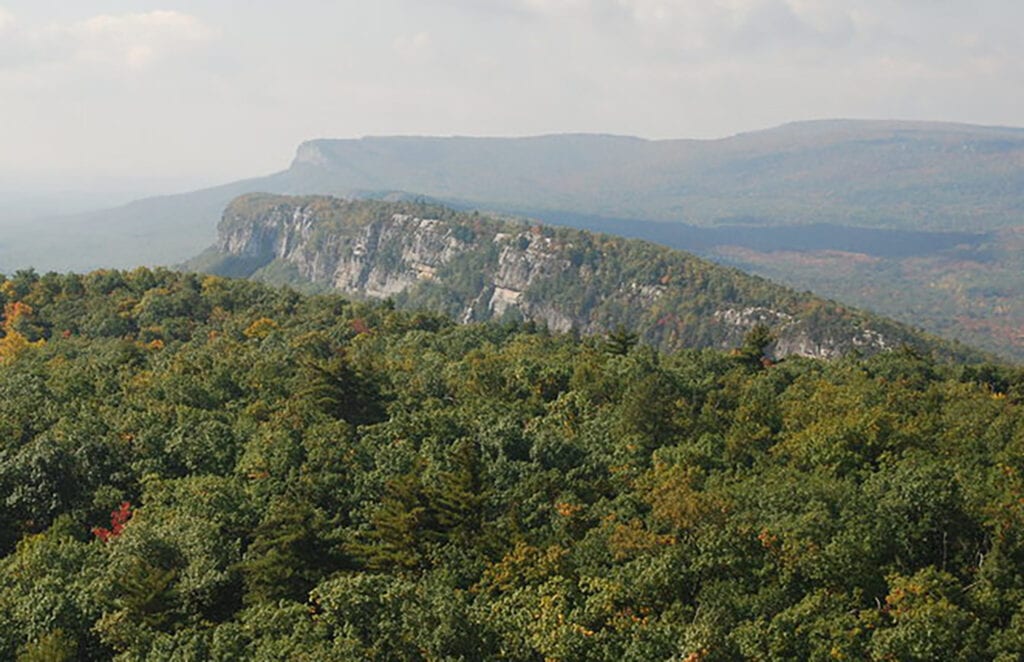
The climbing at the Trapps is accessed by the carriage road that runs the length of the cliff. Smaller approach trails splinter off the carriage road to access the base of the cliff. This makes the approach super casual, but you may need help locating your climb during your first few trips as the climbs are rarely visible below on the carriage road.
Classic Routes in the Trapps
- High Exposure, 5.6
- Modern Times, 5.8
- Cascading Crystal Kaleidoscope, 5.8 PG13
- Directissima, 5.9
- Welcome to the Gunks, 5.10b PG13
- The Sting, 5.11d
The Near Trapps
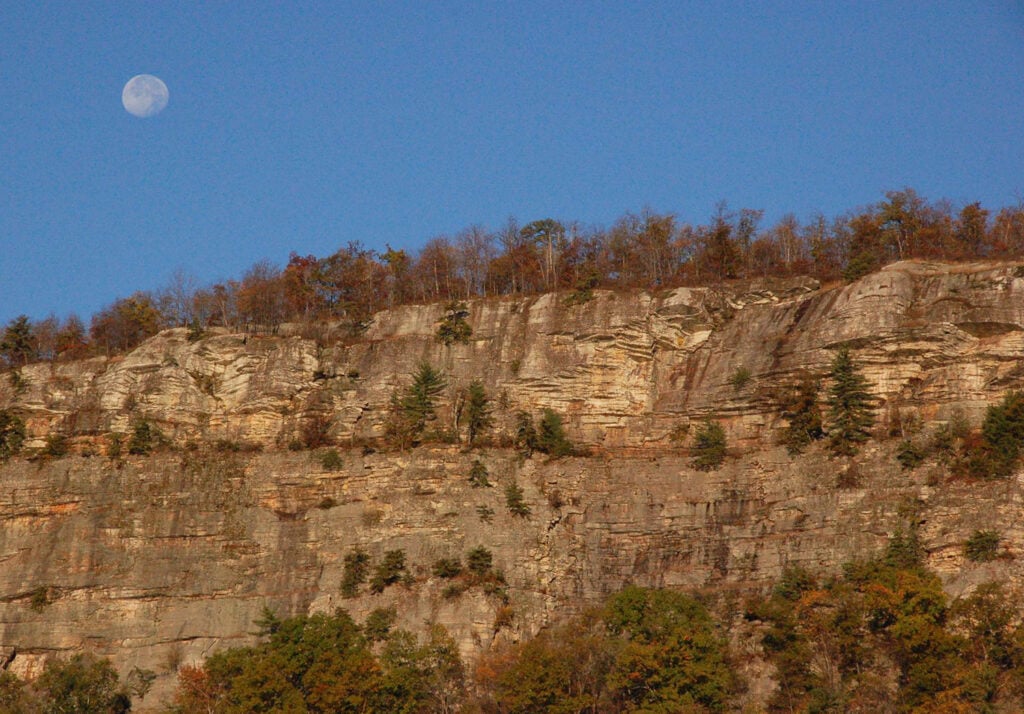
Second in popularity to the Trapps are the Near Trapps. This cliff sports over 200 routes and ranges from 30 to 200 feet high. The most popular section of the Near Trapps cliff is the north side, closest to the parking lot. However, many quality climbs can also be found on the south side of the cliff, about a 15 to 30-minute walk from the parking lot.
Classic Climbs in the Near Trapps
- Disneyland, 5.6
- Land of the Giants, 5.7
- Alphonse, 5.8
- Bird Cage, 5.10b
- Spinal Exam, 5.10c/d
- Infinite Space, 5.12
Peter’s Kill Climbing Area in Minnewaska State Park
Peter’s Kill is affectionately known to the locals as the “miniature Gunks.” It is home to the same type of rock, which lends itself to many horizontal cracks and roof climbing but is only one pitch high. Therefore, Peter’s Kill is perfect for climbers not interested in multi-pitching and who want to top rope.
Accessing the cliffs at Peter’s Kill is done from above via a well-worn trail that runs the length of the cliff. Periodically along the ridgeline, there are access trails that allow you to descend to the base, where a similar access trail can be found.
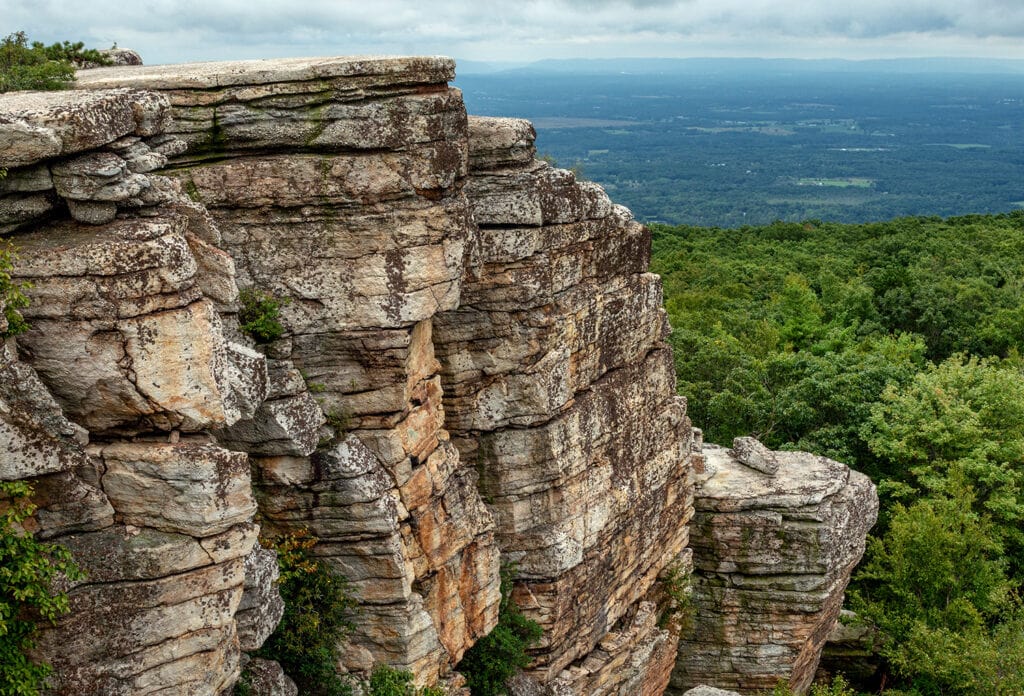
Classic Climbs in Peter’s Kill
- The Kling-On, 5.7
- Psycho Crack Right, 5.8
- The Golden Dream, 5.9
- Oops, 5.10
- Floops, 5.10 PG13
- Writer’s Block, 5.12
Millbrook
The Millbrook zone is relatively remote compared to the other climbing areas in the Gunks. Climbers who want to try the climbs in this area have to be ready to approach roughly 40 minutes. For some climbers, this lends to the attraction of Millbrook because there are fewer crowds.
However, Millbrook also has much fewer climbs. Despite the fewer climbs, Millbrook is well-known for its fantastic rock, scenic views, and generally adventurous (aka run-out) nature.
Classic Climbs in Millbrook
- Westward Ha!, 5.7
- Cruise Control, 5.9
- Schlemiel, 5.10b/c
- High Plains Drifter, 5.10 R
- New Frontier, 5.11b R
Sky Top – private except for climbing with Alpine Endeavors
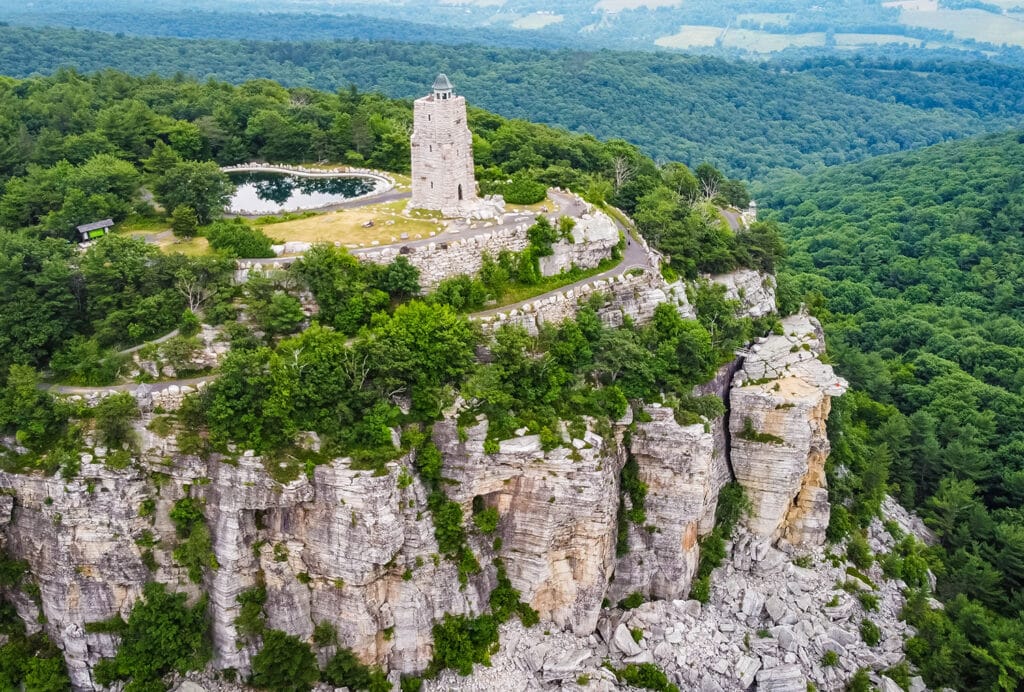
The Sky Top cliff is the long cliff band that sits below the obvious Sky Tower. This area, which is located on the Mohonk Mountain House property, has over 300 climbs ranging from 50 to 150 feet.
In the past, the Sky Top zone was open to public climbing. However, since then, access to the cliff has been revoked. Therefore, the only way to legally climb in the Sky Top area is as a guided client with Alpine Endeavors (12).
Classic Climbs of Sky Top
- Lakeview, 5.4
- Taste of Honey, 5.7
- Sound and Fury, 5.8
- No Exit, 5.10+
- Foops, 5.11c
- Super Crack, 5.12+
Recommended Professional Climbing Guides
When you go rock climbing in a new location, hiring a local professional rock climbing guide can be advantageous. Local guides can show you the best Gunks climbs and teach you new skills like lead climbing and building rope anchors.
Luckily in the Gunks, various climbing services are entrusted with guiding the many routes of the Gunks.
- Mountain Skills Climbing Guides (13)
- High Xposure Adventures (14)
- Alpine Endeavors (15)
- Ragged Mountain Guides (16)
- Alpine Logic (17)
- Advanced Rockcraft (18)
- Vitti Mt Guides (19)
Whether you want a half-day or a full day, any of the guide services we listed above can help. Have a look at their websites to see which guide outfit can help you attain your rock climbing goals.
Practical Tips to Have the Best Experience
Not sure where to start when you arrive at the Mohonk Preserve? Here are some tips to help you have the best time.
Check out the Mohonk Preserve Visitor’s Center
The Mohonk Preserve visitor center is open year-round and can be accessed free of charge anytime between 9 am and 5 pm.
At the visitor center, you can get recreation suggestions, directions, and local geology and wildlife information.
The visitor center is especially lovely if you are traveling with kids. There are various nature-themed games and activities in the Kid’s Corner and a nearby Children’s Forest.
Stop by Rock and Snow
Rock and Snow (20) is a local climbing shop located in New Paltz. The individuals at Rock and Snow are the local specialists in rock climbing, ice climbing, hiking, and cross-country skiing.
The staff at Rock and Snow can answer any questions you might have, equip you with gear, and connect you with local guide services.
Hire a professional rock-climbing guide
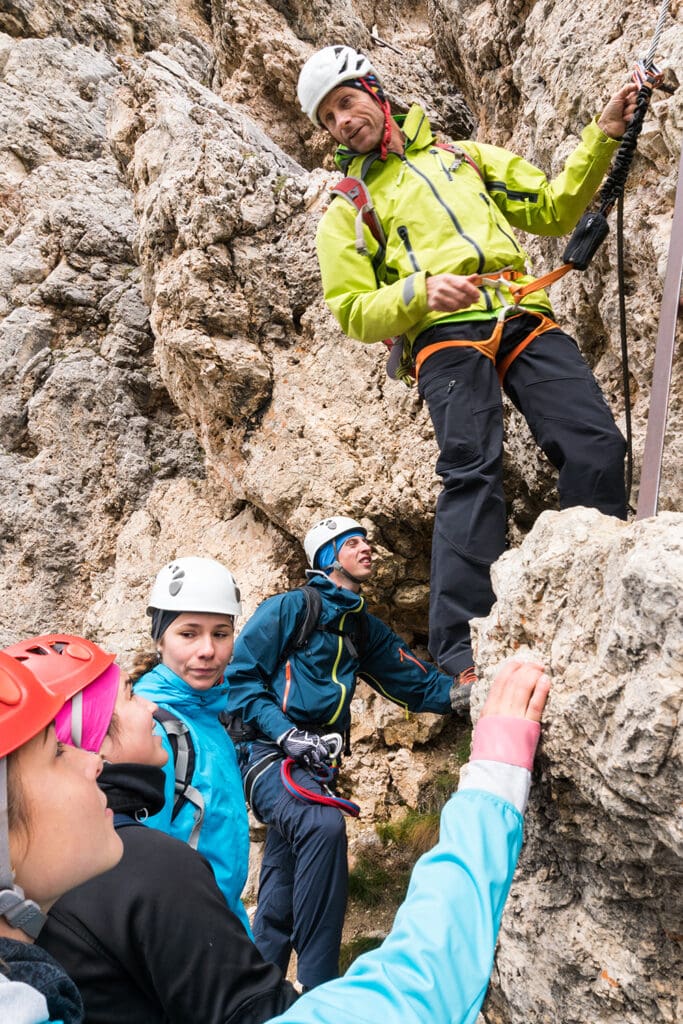
The Gunks is a large place. As a result, trying to navigate the main cliffs and chase down popular routes during the prime climbing season can be intimidating.
Whether you want to try multi-pitch trad climbing or single-pitch climbs, hiring a professional rock-climbing guide can help put your mind at ease. Local guides can help complete a visiting climber’s tick list. Furthermore, guides understand the most efficient way to get you on many classic routes. Plus, they can point you in the direction of local secrets, like the swimming hole.
Take a rest day and enjoy New Paltz
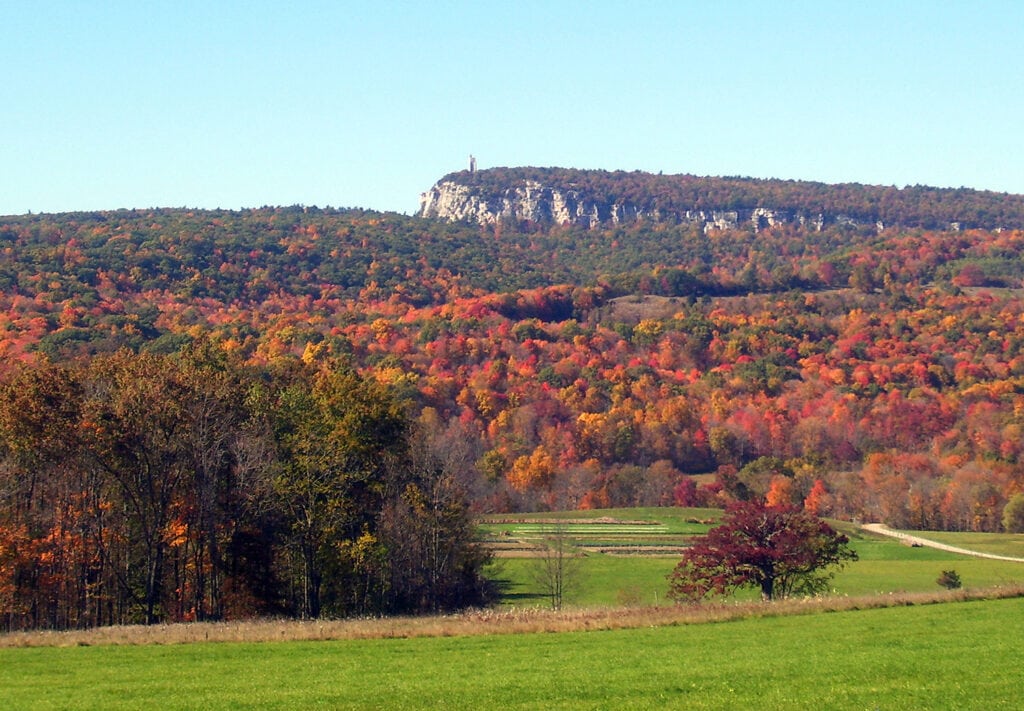
New Paltz is the quiet regional hub of the Shawangunk mountains. The town of New Paltz (21) is a popular weekend destination most known for its outdoor attractions. It’s also a landing zone for climbers and outdoor enthusiasts from the NYC metropolitan area as well as individuals traveling in from farther reaches via the Newark Liberty International Airport.
Recommend Guidebooks & Resources
The Gunks App
The Gunks App is hard to beat if you are interested in having all the information you require at your fingertips. It’s a digital climbing guide you can purchase and download to your phone. Also, there are versions of the Gunks App for both Android and Apple smartphones.
Mountain Project

Mountain Project is a website that functions like a guidebook for more than 170,000 locations throughout the entire globe. The Gunks climbing pages on Mountain Project (22) are very extensive and informative. Mountain Project can be used from your desktop, but you can also download the areas you want to climb to access the information offline from your smartphone while you are at the crag.
Gunks Climbing Guidebooks
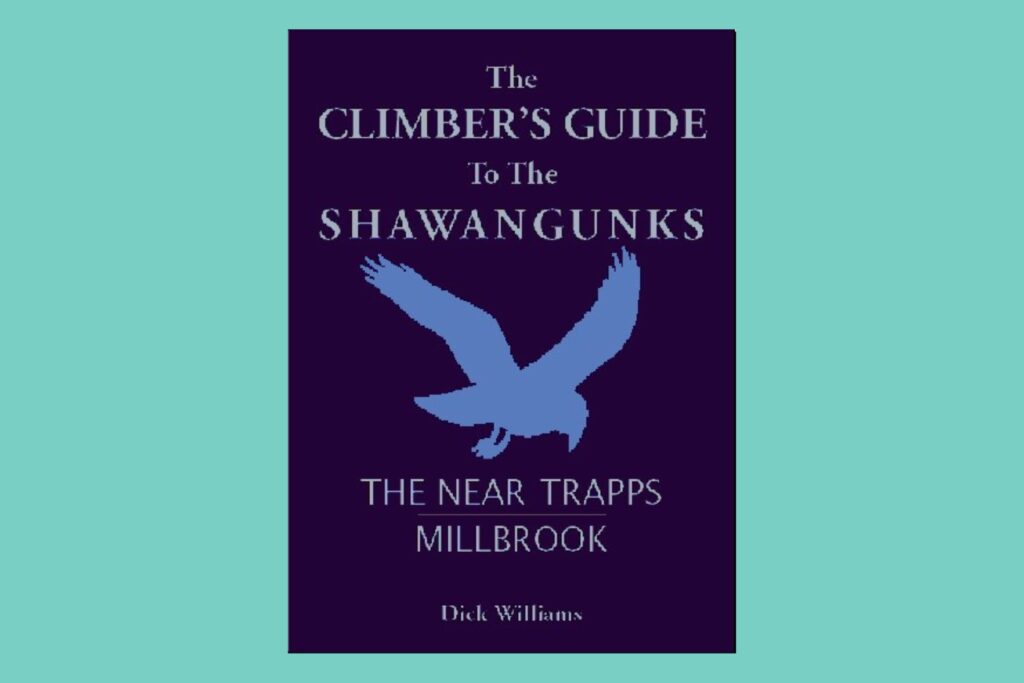
You might prefer a printed guidebook if you prefer the tactile experience of holding a book and flipping through the pages. Luckily, there are a variety of helpful guidebooks that outline the premier climbing areas of the Gunks for both roped climbing and bouldering.
- The Climber’s Guide to the Shawangunks: The Near Trapps and Millbrook; written by Dick Williams.
- Shawangunk Rock Climbs: The Near Trapps and Millbrook; written by Dick Williams.
- The Climber’s Guide to the Shawangunks: The Trapps; written by Dick Williams.
- A Rock Climber’s Guide to the Peter’s Kill Climbing Area; written by Mike Rawdon and Mary Molitoris.
- Peter’s Kill Climbing Guide; Robert Wilson
- Shawangunk Rock Climbs: Sky Top; written by Dick Williams.
Many of these classic guidebooks can be purchased online from various e-commerce retailers. However, you can also buy Gunks guidebooks from the Rock and Snow (23) gear store in New Paltz.
Frequently Asked Questions

The Gunks is a nickname shortened from the full name of the closest mountain range, the Shawangunk Mountains.
The Gunks are located just Northwest of the small town of New Paltz, New York, in the Mohonk Preserve of the Shawangunk Mountains.
No, there is pure sport climbing at the Gunks. Most Gunks climbing is traditional by nature– meaning you place gear into the rock to protect yourself instead of clipping fixed bolts. However, there are sections of certain climbs protected by bolts.
The Gunks are well known for their variety. In the Gunks, you can clip bolts on mixed sport and trad climbs, climb classic routes using only traditional protection, and wrestle pebbles on the boulders at the base of the cliffs.
References
Shawangunk Ridge (retrieved on 12/01/2022)
http://www.nysm.nysed.gov/research-collections/geology/resources/shawangunk-ridge
The Original People and Their Land: The Lenape, Pre-History to the 18th Century (retrieved on 12/01/2022)
https://collaborativehistory.gse.upenn.edu/stories/original-people-and-their-land-lenape-pre-history-18th-century
E-ZPass Information (retrieved on 12/01/2022)
https://www.thruway.ny.gov/ezpass/index.html
Amtrak (retrieved on 12/01/2022)
https://www.amtrak.com/home.html
Metro-North Railroad (retrieved on 12/01/2022)
https://new.mta.info/agency/metro-north-railroad
Ulster County Area Transit (retrieved on 12/01/2022)
https://ucat.ulstercountyny.gov/routes/
New Paltz Hostel (retrieved on 12/01/2022)
https://www.newpaltzhostel.com/
Mohonk Mountain House (retrieved on 12/01/2022)
https://www.mohonk.com/
The American Alpine Club Gunks Campground (retrieved on 12/01/2022)
https://americanalpineclub.org/gunks-campground
Yogi Bear’s Jellystone Park: Lazy River in Gardiner, NY (retrieved on 12/01/2022)
https://lazyriverny.com/
The Minnewaska Lodge (retrieved on 12/01/2022)
https://www.minnewaskalodge.com/
Alpine Endeavors (retrieved on 12/01/2022)
https://alpineendeavors.com/
Mountain Skills Climbing Guides (retrieved on 12/01/2022)
https://www.mountainskills.biz/
High Xposure Adventures (retrieved on 12/01/2022)
https://www.high-xposure.com/
Ragged Mountain Guides (retrieved on 12/01/2022)
https://raggedmountainguides.com/
Alpine Logic (retrieved on 12/01/2022)
https://www.alpine-logic.com/
Advanced Rockcraft (retrieved on 12/01/2022)
https://www.advancedrockcraft.com/
Vitti Mt Guides (retrieved on 12/01/2022)
http://www.vittimountainguides.com/
Rock and Snow (retrieved on 12/01/2022)
https://www.rockandsnow.com/store/
Town of New Paltz (retrieved on 12/01/2022)
https://www.townofnewpaltz.org/
The Gunks Climbing (retrieved on 12/01/2022)
https://www.mountainproject.com/area/105798167/the-gunks
